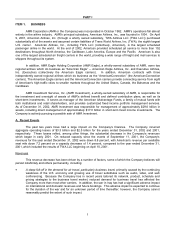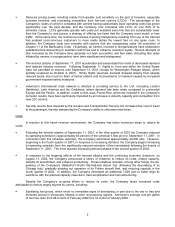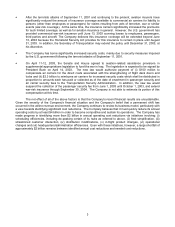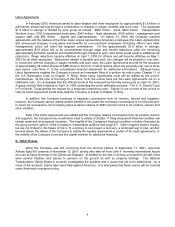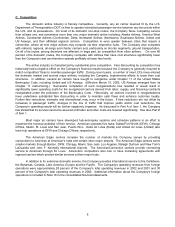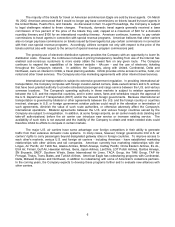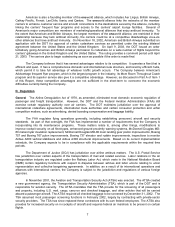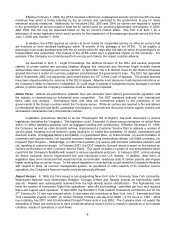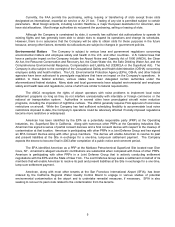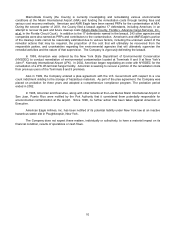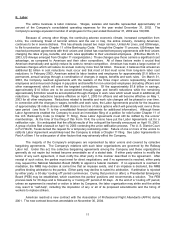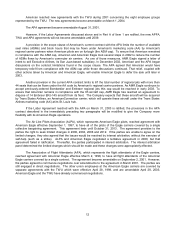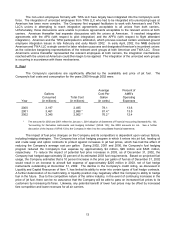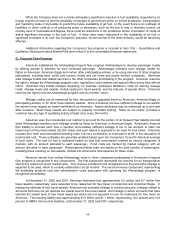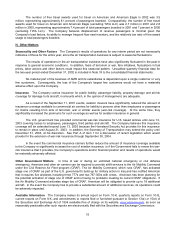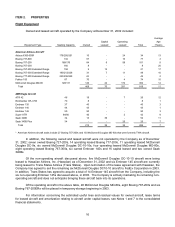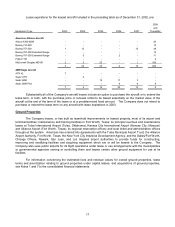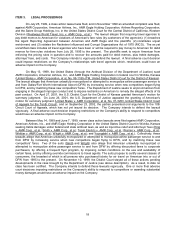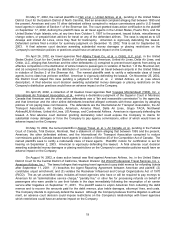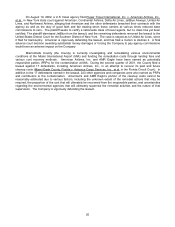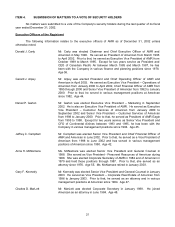American Airlines 2002 Annual Report Download - page 13
Download and view the complete annual report
Please find page 13 of the 2002 American Airlines annual report below. You can navigate through the pages in the report by either clicking on the pages listed below, or by using the keyword search tool below to find specific information within the annual report.
11
E. Labor
The airline business is labor intensive. Wages, salaries and benefits represented approximately 41
percent of the Company’s consolidated operating expenses for the year ended December 31, 2002. The
Company’s average equivalent number of employees for the year ended December 31, 2002 was 109,600.
Because of, among other things, the continuing adverse economic climate, increased competition from
LCCs, the continuing threat of terrorist actions and the war in Iraq, the airline industry, including American,
continues to be in severe distress. This has already caused two major carriers, United Air Lines, and USAirways,
to file for protection under Chapter 11 of the Bankruptcy Code. Through the Chapter 11 process, USAirways has
reached permanent agreements with their unions and United has reached temporary agreements with their unions
changing the rates of pay, benefits, and work rules applicable to their unionized employees. (Effective March 31,
2003, US Airways emerged from Chapter 11 reorganization.) Those changes give those carriers a significant cost
advantage, as compared to American and their other competitors. All of these factors make it crucial that
American dramatically and quickly reduce its costs to remain competitive. American has made a large number of
business changes which will reduce its annual costs by more than $2 billion. However, it believes that at least an
additional $2 billion in cost reductions must occur and that most of that must come from long-term labor cost
reductions. In February 2003, American asked its labor leaders and employees for approximately $1.8 billion in
permanent, annual savings through a combination of changes in wages, benefits and work rules. On March 31,
2003, the Company reached agreements with the leaders of the three major unions representing American
employees and announced changes in pay plans and benefits for non-unionized employees (including officers and
other management) which will meet the targeted contributions. Of the approximately $1.8 billion in savings,
approximately $1.0 billion are to be accomplished through wage and benefit reductions while the remaining
approximately $.8 billion would be accomplished through changes in work rules which would result in additional job
reductions. Wage reductions became effective on April 1, 2003 for officers and will become effective on May 1,
2003 for all other employees. Reductions related to benefits and work rule changes will be phased in over time.
In connection with the changes in wages, benefits and work rules, the Labor Agreements provide for the issuance
of approximately 38 million shares of AMR stock in the form of stock options which will generally vest over a three
year period (see Note 11 to the consolidated financial statements for additional information). Although these
Labor Agreements enabled the Company to avoid an immediate filing of a petition for relief under Chapter 11 of
the U.S. Bankruptcy Code (a Chapter 11 filing), these Labor Agreements must still be ratified by the unions’
memberships. At the time of the filing of this Form 10-K, the unions have put the Labor Agreements out for a
ratification vote. It is anticipated that the official results of the voting will be formally announced on April 15, 2003.
A group of pilots filed a lawsuit on April 14, 2003 contesting the union ratification process. The U. S. District Court
in Fort Worth, Texas denied the request for a temporary restraining order. Failure of one or more of the unions to
ratify its Labor Agreement would likely lead the Company to initiate a Chapter 11 filing. See Labor Agreements in
Part A of Item 1 for a discussion of other factors that may adversely affect the Company.
The majority of the Company’s employees are represented by labor unions and covered by collective
bargaining agreements. The Company’s relations with such labor organizations are governed by the Railway
Labor Act. Under this act, the collective bargaining agreements among the Company and these organizations
generally do not expire but instead become amendable as of a stated date. If either party wishes to modify the
terms of any such agreement, it must notify the other party in the manner described in the agreement. After
receipt of such notice, the parties must meet for direct negotiations, and if no agreement is reached, either party
may request the National Mediation Board (NMB) to appoint a federal mediator. If no agreement is reached in
mediation, the NMB may declare at some time that an impasse exists, and if an impasse is declared, the NMB
proffers binding arbitration to the parties. Either party may decline to submit to arbitration. If arbitration is rejected
by either party, a 30-day “cooling off” period commences. During that period (or after), a Presidential Emergency
Board (PEB) may be established, which examines the parties’ positions and recommends a solution. The PEB
process lasts for 30 days and is followed by a “cooling off” period of 30 days. At the end of a “cooling off” period,
unless an agreement is reached or action is taken by Congress, the labor organization may strike and the airline
may resort to “self-help”, including the imposition of any or all of its proposed amendments and the hiring of
workers to replace strikers.
American reached a new contract with the Association of Professional Flight Attendants (APFA) during
2001. The new contract becomes amendable on November 30, 2004.


